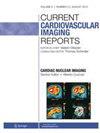Cardiovascular Magnetic Resonance Assessment of Immunotherapy Cardiotoxicity
IF 0.6
Q4 RADIOLOGY, NUCLEAR MEDICINE & MEDICAL IMAGING
引用次数: 0
Abstract
Abstract Purpose of Review To review the current and future role of cardiovascular magnetic resonance (CMR) assessment of immunotherapy cardiotoxicity. Recent Findings In patients who suffer from immune checkpoint inhibitor (ICI) myocarditis, pathologic CMR findings, including myocardial edema, reduced left ventricular ejection fraction (LVEF), late gadolinium enhancement (i.e., fibrosis and/or necrosis), and myocardial strain, are mostly subtle, but fulminant courses have been described. Individual cases of cardiotoxicity in chimeric antigen receptor (CAR) T cell therapy have also already been documented, but there are currently no studies addressing the role of CMR in CAR T cell therapy. There are also classes of immunotherapies for which no cases of cardiotoxicity are known yet, such as cytokines or adjuvants. Summary Together with patient symptoms, laboratory markers, electrocardiogram, and echocardiography, CMR is of high value in the diagnostic workup of immunotherapy-associated myocarditis in hemodynamically stable patients, according to recent guidelines. Additionally, quantitative strain analysis and T1 relaxation times with CMR can aid in assessing disease severity, prognosis, and patient outcomes with ICI-associated myocarditis. Future CMR studies on cardiotoxicity in CAR T cell therapy are needed.心血管磁共振评价免疫治疗心脏毒性
综述心血管磁共振(CMR)评估免疫治疗心脏毒性的现状和未来作用。在免疫检查点抑制剂(ICI)心肌炎患者中,病理CMR表现,包括心肌水肿、左心室射血分数(LVEF)降低、晚期钆增强(即纤维化和/或坏死)和心肌应变,大多是微妙的,但已经描述了暴发性病程。嵌合抗原受体(CAR) T细胞治疗的个别心脏毒性病例也已被记录,但目前还没有研究解决CMR在CAR T细胞治疗中的作用。还有一些类型的免疫疗法目前还没有发现心脏毒性的病例,比如细胞因子或佐剂。根据最新的指南,CMR与患者症状、实验室标志物、心电图和超声心动图一起,在血液动力学稳定的免疫治疗相关性心肌炎的诊断工作中具有很高的价值。此外,CMR定量应变分析和T1松弛时间可以帮助评估ci相关心肌炎的疾病严重程度、预后和患者预后。CAR - T细胞治疗的心脏毒性还需要进一步的CMR研究。
本文章由计算机程序翻译,如有差异,请以英文原文为准。
求助全文
约1分钟内获得全文
求助全文
来源期刊

Current Cardiovascular Imaging Reports
RADIOLOGY, NUCLEAR MEDICINE & MEDICAL IMAGING-
CiteScore
2.20
自引率
0.00%
发文量
7
期刊介绍:
Cardiovascular imaging technologies now play an expanded role in clinical practice. Beyond the diagnosis of a disease process, these techniques are rapidly transitioning to help guide therapy. The journal aims to keep readers current with rapidly evolving advances in instrumentation and imaging procedures that support the expanded role of these technologies in clinical practice. The journal intends to place the entire area of cardiovascular imaging in its proper prospective by establishing the indications and limitations of each imaging technique and by summarizing recent clinical advances.
We accomplish this aim by appointing international authorities to serve as Section Editors in key subject areas across the field, including cardiac magnetic resonance, nuclear imaging, echocardiography, cardiac computed tomography, intravascular, molecular, and hybrid imaging. Section Editors select topics for which leading experts contribute comprehensive review articles that emphasize new developments and recently published papers of major importance, highlighted by annotated reference lists. An Editorial Board of internationally diverse members ensures that topics include emerging research and suggests topics of special interest to their country/region. We also provide commentaries from well-known figures in the field.
 求助内容:
求助内容: 应助结果提醒方式:
应助结果提醒方式:


